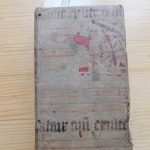The digital copy of the fragment was submitted to our research group by Edina Gordán, librarian of the Bethlen Gábor Documentary Library in July 2022. Thanks are due to her for her help with the description of the host book.
The parchment leaf used as a cover is faded, the text and the notation are difficult to read. The upper line of text, and the two extant lines of text and music below it, preserve parts of the introit of the Mass of St John the Baptist Ne timeas Zacharia and the corresponding verse Domine in virtute tua. In the upper line a fragment of the text adhuc ex utero m[atris] remains from the main part of the introit, ending in the second line with gaudebunt, which can only be inferred from the note -g- belonging to the syllable –bunt. The repetitive -d- of the psalm recitation and the corresponding text: [sa]lutare tuum exulta[bit vehementer] are faintly but clearly visible. At the bottom, the top of the gradual Fuit homo missus a Deo can be identified, presumably following the introit. The preserved neumes suggest a deep-register chant, which is corresponding to the opening part of Fuit homo.
Zsuzsa Czagány




